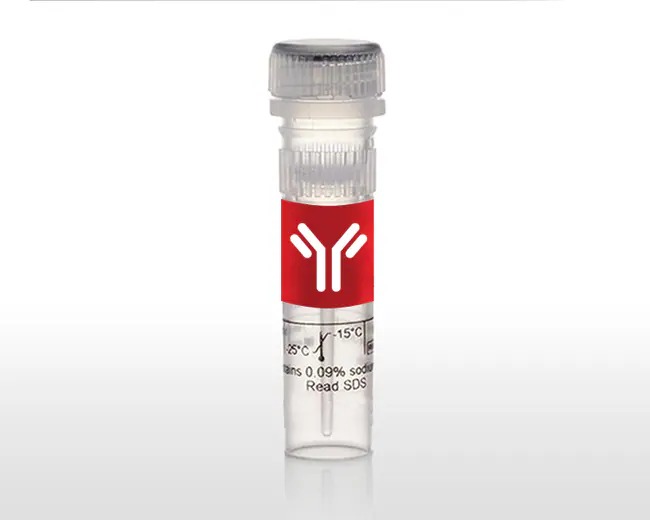Invitrogen™ eBioscience™ CD195 (CCR5) Monoclonal Antibody (NP-6G4), PE, 100 Tests
Catalog No :
CAS Number :
Brand :
In Stock
Specifications:
| Application | Flow Cytometry | ||
| Storage Temperature | 2-8°C | ||
| Product Type | antibody | Forms | Liquid |
| Product Brand | Thermo Fisher Scientific™ | ||
| Product Grade | Molecular Biology | ||
Invitrogen™ eBioscience™ CD195 (CCR5) Monoclonal Antibody (NP-6G4), PE
The Invitrogen™ eBioscience™ CD195 (CCR5) Monoclonal Antibody (NP-6G4) is a fluorescently labeled reagent conjugated with PE (Phycoerythrin), specifically designed for the detection of CCR5, a chemokine receptor critical in immune cell trafficking and a primary co-receptor for HIV-1 entry into host cells. Optimized for flow cytometry, this antibody is pre-titrated and validated for consistent and reliable results.
Key Features
- Target Molecule (CCR5/CD195):
- CCR5 is a chemokine receptor expressed on memory/effector T cells, monocytes, macrophages, and dendritic cells.
- It binds chemokines such as MIP-1α, MIP-1β, and RANTES to mediate immune cell chemotaxis.
- Serves as a primary co-receptor for HIV-1, facilitating viral entry through interactions with CD4 and gp120 (1, 2).
- Conjugate:
- PE (Phycoerythrin) is a bright fluorophore with an excitation maximum of 565 nm and an emission maximum of 576 nm, making it ideal for multicolor flow cytometry panels (3).
- Applications:
- Designed for flow cytometric analysis of CCR5 expression in human immune cells.
- Commonly used in HIV research, immune cell phenotyping, and chemokine receptor signaling studies (4).
- Format and Purification:
- Provided in a liquid formulation, purified via affinity chromatography, and stabilized in PBS with 0.2% BSA and 0.09% sodium azide to ensure optimal performance (5).
Specifications
| Property | Details |
|---|---|
| Clone | NP-6G4 |
| Host/Isotype | Mouse / IgG1, kappa |
| Conjugate | PE (Phycoerythrin) |
| Excitation/Emission | 565 nm / 576 nm |
| Species Reactivity | Human |
| Applications | Flow cytometry |
| Concentration | 5 µL/test (0.125 µg/test) |
| Formulation | PBS (pH 7.2), 0.2% BSA, 0.09% sodium azide |
| Storage Conditions | 4°C, store in the dark; DO NOT FREEZE |
| Shipping Conditions | Ambient (domestic); Wet ice (international) |
| Regulatory Use | Research Use Only |
Applications
- Flow Cytometry:
- Detection and quantification of CCR5+ immune cells, including T cells, monocytes, and dendritic cells.
- HIV Research:
- Study CCR5’s role as a co-receptor in HIV-1 entry and its inhibition by chemokines such as RANTES and MIP-1β (6).
- Immune Cell Phenotyping:
- Characterize memory/effector T cell populations and their role in chemotaxis and immune responses.
- Chemokine Receptor Studies:
- Analyze CCR5-mediated cell migration and signaling in normal and diseased states, including inflammation and autoimmune diseases (7).
Handling and Storage
- Storage Conditions: Store at 4°C in the dark to maintain fluorochrome integrity. Avoid freezing to prevent damage to the antibody and PE conjugate.
- Optimal Staining Conditions: For best results, incubate samples with the antibody at 37°C for 1 hour in Flow Cytometry Staining Buffer (Product #00-4222-57).
- Fixation Compatibility: Compatible with IC Fixation Buffer for sample storage post-staining (Product #00-822-49).
Key Advantages
- Bright Fluorescence:
- PE’s high quantum yield provides excellent signal-to-noise ratio for sensitive detection.
- Specificity and Purity:
- The NP-6G4 clone ensures highly specific binding to CCR5, minimizing background noise.
- Broad Utility:
- Ideal for research in HIV pathogenesis, immune cell trafficking, and chemokine receptor signaling.
Target Information
CCR5 is a G protein-coupled receptor (GPCR) critical for immune cell migration and HIV infection. It binds ligands such as RANTES, MIP-1α, and MIP-1β, facilitating cell migration to sites of inflammation (8). Its role as an HIV co-receptor highlights its importance in viral pathogenesis, making it a key target for therapeutic interventions in HIV and inflammatory diseases (9).
References
- Deng, H., et al. "Identification of a major co-receptor for primary isolates of HIV-1." Nature 381.6584 (1996): 661-666.
- Dragic, T., et al. "HIV-1 entry into CD4+ cells is mediated by the chemokine receptor CC-CKR-5." Nature 381.6584 (1996): 667-673.
- Invitrogen™ Datasheet for CD195 Monoclonal Antibody, PE (Product #12-1959-42).
- Liao, F., et al. "Human CCR5: a chemokine receptor for HIV-1 infection and T-cell chemotaxis." Current Opinion in Immunology 9.4 (1997): 479-486.
- Zlotnik, A., et al. "Chemokines and chemokine receptors: insights into their roles in tumor biology." Cancer Letters 267.2 (2008): 167-182.
- Mack, M., et al. "Expression and characterization of the chemokine receptors CCR2 and CCR5 in mice." Journal of Immunology 166.7 (2001): 4697-4704.
- Sallusto, F., et al. "Role of chemokine receptors in immune cell migration." Annual Review of Immunology 17.1 (1999): 593-620.
- González-Martín, A., et al. "CCR5 in infection, inflammation, and cancer." Immunological Reviews 273.1 (2016): 41-58.
- Olson, W. C., et al. "CCR5 monoclonal antibodies for the treatment of HIV-1 infection." Current Opinion in HIV and AIDS 5.4 (2010): 296-303.
The Invitrogen™ eBioscience™ CD195 (CCR5) Monoclonal Antibody (NP-6G4), PE is a robust and reliable reagent for detecting CCR5 in flow cytometry applications. Its bright fluorescence, high specificity, and relevance to HIV and immune research make it an essential tool for studying immune cell migration and pathogenesis.




 0
0
